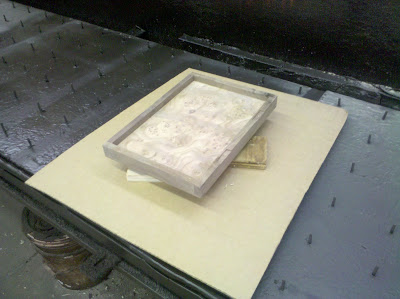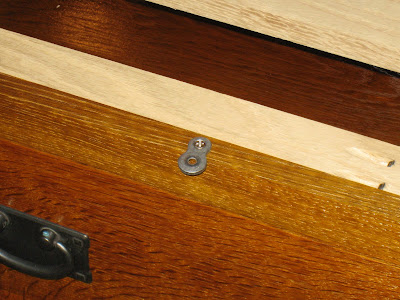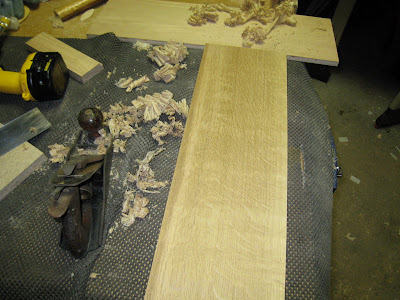Here is the inside of the box. There is a couple of steps in there that I haven't covered. First, there are some runners for the inner box to ride on. The other is the lid aligner? I'm not sure what you call it, but it's an inner frame that when the lid is closed, will align the top half and lower half. That's the theory anyway. :-)

Inside of the box.
Here is the box thus far. There is an applied molding on the lid, and I rolled over the top edge.

Shot of the box closed.
I didn't take any picture about how I made the inner tray, but it was slicing a 3/4 board in half, and planing it to thickness. I then ripped it to height and cut to length. Finally, I cut a groove for the bottom.

Inner Tray.
In my last post, I pointed out my opportunity. Here is what I decided. I decided to leave the knothole. It's character to the piece, and I didn't want to loose that. I did want to try and take care of the chipout on the pins. I mixed up some 15 minute epoxy and added some black pigment. Next I taped off the area and added the epoxy.

Filling the holes.
When you need to mark something accurately, you mark it with a knife. It's there somewhere.

Marking it with a knife.
After the ruler has located the place for the hinge, I slid the hinge into it. Pretty self explanatory.

Putting the hinge in place.
Now that I got the top cut off, it's time to put them back together. I'm using a square to guesstimate the location. That looks about right. I'll come in from that same distance on both sides.

Hinge layout.
I want to get as tight a joint as I can, and my No. 4 plane will get me really close. I'll do all four corners, on both sides of the lid, and then check to see how they match up.

Planing the joint smooth.
It would be useless as a jewelry box if you can't open it, and here is how I did it. I took out my standard blade in my saw, and put in a skil saw blade. The idea here is I wanted to remove as little material as possible, and that blade was about half as thick as my heavy duty blade. The trade off is that the blade had quite a bit of chatter and didn't yield as smooth a cut as I would have liked.

Getting ready to cut the top off.
I'm terrible at keeping on top of this, so here is my catchup post to get me back to where I'm at on this project. I've got all of the boxes out of the clamps, planed and sanded them smooth.

Out of the clamps and ready for cutting.
























































